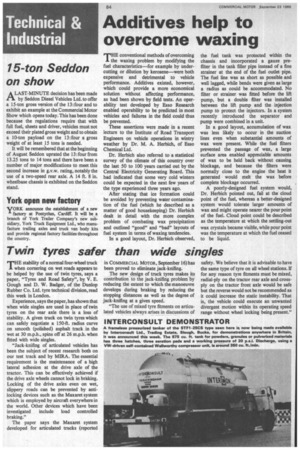Twin tyres safer than wide singles
Page 86

If you've noticed an error in this article please click here to report it so we can fix it.
THE stability of a normal four-wheel truck when cornering on wet roads appears to be helped by the use of twin tyres, says a paper, "Tyres and Road Safety", by V. E. Gough and D. W. Badger, of the Dunlop Rubber Co. Ltd. tyre technical division, read this week in London.
Experience, says the paper, has shown that when wide singles are used in place of twin tyres on the rear axle there is a loss of stability. A given truck on twin tyres which can safely negotiate a 150-ft. radius curve on smooth (polished) asphalt track in the wet at 30 m.p.h., spins off at 26 m.p.h. when fitted with wide singles.
"Jack-knifing of articulated vehicles has been the subject of recent research both on our test track and by MIRA. The essential requirement is the maintenance of a high lateral adhesion at the drive axle of the tractor. This can be effectively achieved if the drive axle wheels cannot lock in braking. Locking of the drive axles even on wet, slippery roads can be prevented by antilocking devices such as the Maxaret system which is employed by aircraft everywhere in the world. Other devices which have been investigated include load controlled braking."
The paper says the Maxaret system developed for articulated trucks (reported
in COMMERCIAL MOTOR, September 16) has been proved to eliminate jack-knifing.
The new design of truck tyres makes its contribution to the jack-knifing problem by reducing the extent to which the manoeuvre develops during braking by reducing the stopping distances as well as the degree of jack-knifing at a given speed.
"The use of mixed tyre fitments on articulated vehicles always arises in discussions of safety. We believe that it is advisable to have the same type of tyre on all wheel stations. If for any reason tyre fitments must be mixed, radial-ply on the tractor rear axle and crossply on the tractor front axle would be safe but the reverse would not be recommended as it could increase the static instability. That is, the vehicle could execute an unwanted divergent motion within its operating speed range without wheel locking being present."








































































































































































































































































































































































